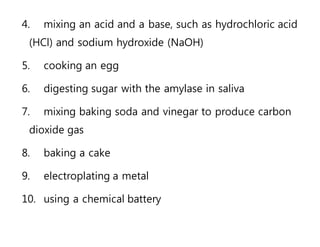Visual aid for
- 1. Physical change A physical change is a change in which no new substances are formed and most
- 2. physical changes are reversible. Examples: changes of shape, changes of states. Special details which do not change in a substance without new substances being formed are called physical properties. Example: change of water into ice or water vapor, change of density. Paraffin wax, which is solid before heating and liquid
- 3. after heating. Some physical changes are melting, freezing, boiling point. Chemical changes involve chemical reactions and the creation of new products. Typically, a chemical change is irreversible. This is a list of 10 examples of chemical changes. 1. rusting of iron 2. combustion (burning) of wood 3. metabolism of food in the body
- 4. 4. mixing an acid and a base, such as hydrochloric acid (HCl) and sodium hydroxide (NaOH) 5. cooking an egg 6. digesting sugar with the amylase in saliva 7. mixing baking soda and vinegar to produce carbon dioxide gas 8. baking a cake 9. electroplating a metal 10. using a chemical battery



